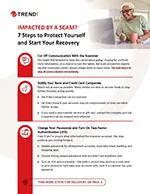Discovering that you’ve been scammed can feel overwhelming. You might be shocked, confused, or unsure what to do next. These are natural reactions—and you’re not alone. Millions of people experience scams every year, and the emotional fallout can be just as distressing as any financial loss.
Scammers today are highly sophisticated. Many operate as part of organized criminal networks and use advanced tools to deceive people. Their tactics often involve personal details from data breaches, realistic-looking websites that mimic trusted brands, fake customer reviews, and even sponsored ads on social media or search engines. Some create convincing fake profiles that match your interests or needs. Increasingly, they’re using generative AI to craft polished emails, videos, and deepfake content that appear entirely legitimate.
“Scammers are exploiting trust at scale, using technology that can fool even the most experienced internet users. Instead of blaming victims, we need to focus on education, support, and smarter prevention.”
— Lynette Owens, VP, Global Consumer Education, Trend Micro
Scams are designed to deceive even the most cautious person. Whether you’re tech-savvy, a professional in your field, or consider yourself generally skeptical, being impacted by a scam is not a reflection of your intelligence or judgment. It means someone used sophisticated, deceptive methods specifically designed to bypass your defenses.
Before taking action, give yourself a moment to take stock. Try to recall what happened and what information or access may have been shared. Then, follow the steps below to begin securing your accounts, protecting your identity, and moving forward.
Download PDF Tip Sheet

IMPACTED BY A SCAM?
7 Steps to Protect Yourself and Start Your Recovery
If you’ve sent money, shared personal information, or clicked a link and now feel uneasy, it’s worth taking steps to protect yourself—even if you’re not sure yet whether it was a scam. Scammers often leave people second-guessing what just happened, and that uncertainty is a common part of the experience.
When in doubt, it’s better to be cautious. The worst-case scenario is that you’ve updated your credentials, strengthened your account security, and taken a close look at your finances—things that are useful to do regularly anyway. Taking action gives you peace of mind and helps ensure you stay protected moving forward.
In some cases, yes—especially if you act quickly. Contact your bank, credit card provider, or payment service as soon as possible. Some financial institutions can reverse fraudulent transactions, issue chargebacks, or help you secure your accounts. If you paid with a gift card or wire transfer, contact the company immediately to ask if the transaction can be stopped or refunded.
If you entered your password or account details—or clicked on a link that now gives you second thoughts—it’s important to take steps to protect yourself. These actions are common ways scammers gain access to personal information or install harmful software, often without the person realizing it in the moment.
Start by changing your passwords, especially for your email, banking, and shopping accounts. If you’ve reused that password elsewhere, update each account with a strong, unique password. Wherever possible, turn on two-factor authentication (2FA) to add an extra layer of protection.
If clicking the link led to a download or took you to a site that didn’t seem right, your device may have been exposed to malware—such as programs that record keystrokes or capture your personal information in the background. Run a full scan using trusted antivirus or anti-malware software to check for and remove any threats.
To reduce your risk going forward, consider using a free tool like Trend Micro ScamCheck. It can help you review links, messages, and even images before you interact with them—giving you an added layer of protection in real time.
Yes. Reporting helps track scam patterns and can prevent others from being impacted—even if you avoided financial loss yourself.
Protect Yourself with Trend Micro ScamCheck
With the increasing number and sophistication of scams, staying one step ahead is more crucial than ever. Unfortunately, antivirus software alone isn’t enough. Introducing the newly updated Trend Micro ScamCheck! Available for both Android and iOS, ScamCheck offers comprehensive protection from deceptive phishing scams, scam and spam text messages, deepfakes, and more:
- Scam Check: Instantly analyze emails, texts, URLs, screenshots, and phone numbers with our AI-powered scam detection technology. Stay secure and scam-free.
- SMS Filter & Call Block: Say goodbye to unwanted spam and scam calls and messages. Minimize daily disruptions and reinforce your defenses against phishing.
- AI Video Scan: Detect deepfakes in real-time during video calls, alerting you if anyone is using AI face-swapping technology to alter their appearance.
- Web Guard: Surf the web safely, protected from malicious websites and annoying ads.
To download Trend Micro ScamCheck or to learn more, click the button below.
Marike Kuyper is responsible for designing consumer education programs at Trend Micro. With a passion for empowering learners, she brings a deep understanding of learning design to her work in creating online safety programs for adults, youth, and educators worldwide. Marike has over 12 years of experience in education. Prior to joining Trend Micro, she held various positions at schools, NGOs, and non-profit organizations, supporting community outreach, education, and vulnerable populations.
